
ГЛАТИРАМЕРО ВИАТРИС 20 мг/мл РАСТВОР ДЛЯ ИНЪЕКЦИЙ В ПРЕДНАПОЛНЕННОМ ШПРИЦЕ
Спросите врача о рецепте на ГЛАТИРАМЕРО ВИАТРИС 20 мг/мл РАСТВОР ДЛЯ ИНЪЕКЦИЙ В ПРЕДНАПОЛНЕННОМ ШПРИЦЕ

Инструкция по применению ГЛАТИРАМЕРО ВИАТРИС 20 мг/мл РАСТВОР ДЛЯ ИНЪЕКЦИЙ В ПРЕДНАПОЛНЕННОМ ШПРИЦЕ
Введение
Прошпект: Информация для пользователя
Глатиример Виатрис 20мг/мл раствор для инъекций в предварительно заполненном шприце
глатиример, ацетат
Прочитайте внимательно весь прошпект перед началом использования этого лекарства, поскольку он содержит важную информацию для вас.
- Сохраните этот прошпект, поскольку вам может потребоваться прочитать его снова.
- Если у вас есть какие-либо вопросы, проконсультируйтесь с вашим врачом или фармацевтом.
- Это лекарство было назначено только вам, и не передавайте его другим людям, даже если у них такие же симптомы, как у вас, поскольку оно может нанести им вред.
- Если вы испытываете любой тип побочного эффекта, проконсультируйтесь с вашим врачом или фармацевтом, даже если это побочные эффекты, которые не указаны в этом прошпекте. См. раздел 4.
Содержание прошпекта
- Что такое Глатиример Виатрис и для чего он используется
- Что вам нужно знать перед началом использования Глатиримера Виатрис
- Как использовать Глатиример Виатрис
- Возможные побочные эффекты
- Хранение Глатиримера Виатрис
- Содержание упаковки и дополнительная информация
1. Что такое Глатиример Виатрис и для чего он используется
Глатиример Виатрис - это лекарство, используемое для лечения рецидивирующих форм рассеянного склероза (РС). Он изменяет способ функционирования иммунной системы вашего организма и классифицируется как иммуномодулирующий агент. Считается, что симптомы РС возникают из-за дефекта иммунной системы организма. Это приводит к зонам воспаления в мозге и спинном мозге.
Глатиример используется для снижения количества случаев, когда вы испытываете приступы РС (рецидивы). Не было доказано, что он помогает, если вы страдаете какой-либо формой РС, не имеющей рецидивов или почти не имеющей рецидивов. Глатиример Виатрис может не иметь никакого эффекта на продолжительность приступа РС или на тяжесть ваших симптомов во время приступа.
Он используется для лечения пациентов, которые могут ходить без помощи.
Глатиример также может использоваться у пациентов, которые впервые испытывают симптомы, указывающие на высокий риск развития РС. Ваш врач исключит любую другую причину, объясняющую эти симптомы, прежде чем начать лечение.
2. Что вам нужно знать перед началом использования Глатиримера Виатрис
Не используйте Глатиример Виатрис
- Если вы аллергичны к ацетату глатиримера или к любому другому компонентуэтого лекарства (перечисленному в разделе 6).
Предостережения и меры предосторожности
Проконсультируйтесь с вашим врачом или фармацевтом перед началом использования Глатиримера Виатрис:
- Если у вас есть какая-либо проблема с почками или сердцем, поскольку вам может потребоваться периодически проходить анализы или осмотры.
- Если у вас есть или были проблемы с либидо (включая те, которые связаны с потреблением алкоголя).
Глатиример Виатрис может вызывать тяжелые аллергические реакции, некоторые из которых могут быть потенциально смертельными.
Эти реакции могут возникнуть вскоре после введения, даже через месяцы или годы после начала лечения, и даже если ранее не было аллергических реакций после предыдущих введений.
Симптомы аллергических реакций могут совпадать с реакциями после инъекции. Ваш врач проинформирует вас о симптомах аллергической реакции.
Дети
Глатиример не может использоваться у детей младше 12 лет.
Пациенты пожилого возраста
Фармакокинетика глатиримера не изучалась специально у людей пожилого возраста. Проконсультируйтесь с вашим врачом по этому поводу.
Другие лекарства и Глатиример Виатрис
Сообщите вашему врачу или фармацевту, если вы используете, недавно использовали или можете использовать любое другое лекарство.
Беременность и лактация
Если вы беременны, думаете, что можете быть беременной или планируете стать беременной, проконсультируйтесь с вашим врачом, чтобы он посоветовал вам о лечении глатиримером во время беременности.
Глатиример может использоваться во время беременности в соответствии с рекомендациями вашего врача.
Ограниченные данные о людях не показали негативного влияния ацетата глатиримера на новорожденных/младенцев. Глатиример может использоваться во время лактации.
Вождение и использование машин
Глатиример не влияет на способность управлять транспортными средствами или использовать машины.
3. Как использовать Глатиример Виатрис
Следуйте точно инструкциям по введению, указанным вашим врачом для этого лекарства. В случае сомнений проконсультируйтесь снова с вашим врачом или фармацевтом.
Рекомендуемая суточная доза для взрослых и подростков от 12 лет - один предварительно заполненный шприц (20 мг ацетата глатиримера), вводимый под кожу (подкожно).
Очень важно, чтобы инъекция Глатиримера Виатрис была выполнена правильно:
- Только в ткани под кожей (подкожной ткани) (см. «Инструкции по использованию» ниже).
- В дозе, указанной вашим врачом. Вводите только назначенную вашим врачом дозу.
- Никогда не используйте один и тот же шприц более одного раза. Любый непользованный или оставшийся продукт должен быть утилизирован.
- Не смешивайте или не вводите одновременно содержимое предварительно заполненных шприцев глатиримера с любым другим продуктом.
- Если раствор содержит частицы, не используйте его. Используйте новый шприц.
Впервые, когда вы используете глатиример, вам будут даны полные инструкции, и вас будет наблюдать врач или медсестра. Они будут с вами во время инъекции и в течение 30 минут после нее, только чтобы убедиться, что у вас нет проблем.
Инструкции по использованию
Прочитайте эти инструкции внимательно перед использованием глатиримера.
Перед инъекцией убедитесь, что у вас есть все необходимое:
- Блистер с предварительно заполненным шприцем глатиримера.
- Контейнер для утилизации использованных игл и шприцев.
- Для каждой инъекции выньте только один блистер с предварительно заполненным шприцем из упаковки. Храните остальные шприцы в коробке.
- Если ваш шприц был в холодильнике, выньте блистер, содержащий шприц, как минимум за 20 минут до того, как вы собираетесь сделать инъекцию, чтобы он нагрелся до комнатной температуры.
Тщательно вымойте руки водой и мылом.
Если вы хотите использовать устройство для инъекции, чтобы сделать инъекцию, вы можете использовать устройство для инъекции предварительно заполненных шприцев глатиримера. Устройство для инъекции предварительно заполненных шприцев одобрено только для использования с Глатиримером Виатрис и не было протестировано с другими продуктами. Прочитайте инструкции по использованию, предоставленные с устройством для инъекции предварительно заполненных шприцев.
Выберите место для инъекции внутри указанных областей, следуя схемам.
Существует семь возможных зон для инъекции на вашем теле:
Область 1: область живота (абдомена) вокруг пупка. Избегайте области 5 см вокруг пупка.
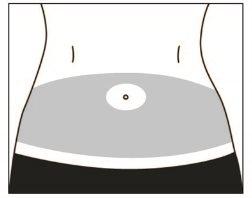
Области 2 и 3: Бедра (над коленями)
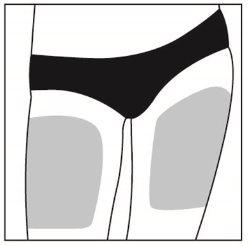
Области 4, 5, 6 и 7: Задняя часть верхней части рук, нижняя часть тазобедренной области (ниже пояса).
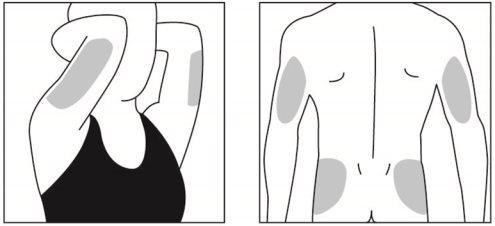
В каждой области инъекции есть несколько мест, где можно сделать инъекцию. Выберите разное место для инъекции каждый день. Это уменьшит вероятность раздражения или боли в месте инъекции. Меняйте место инъекции внутри каждой области. Не используйте всегда одно и то же место для инъекции.
Предупреждение:не вводите в любую область, которая болит или без цвета, или в месте, где вы заметили узлы или твердые уплотнения. Рекомендуется иметь схему с запланированными местами инъекции и записать их в дневник. Существуют некоторые места на вашем теле, которые могут быть трудными для самостоятельной инъекции (например, задняя часть руки). Если вы хотите использовать их, вам может потребоваться помощь.
Как сделать инъекцию:
- Выньте шприц из защитного блистера, снимая заднюю часть блистера.
- Снимите колпачок с иглы; не используйте рот или зубы для этого.
- Аккуратно сожмите кожу, делая складку между большим и указательным пальцами (Рисунок 1).
- Вставьте иглу в кожу так, как показано на Рисунке 2.
- Введение препарата, толкая поршеньfirmly до упора, оставляя шприц пустым.
- Выньте шприц и иглу.
- Утилизируйте шприц в безопасном контейнере для отходов. Не выбрасывайте использованные шприцы в мусор, осторожно поместите их в контейнер, устойчивый к проколам, как рекомендовал ваш врач или медсестра.
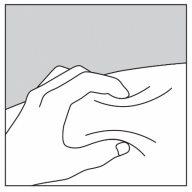
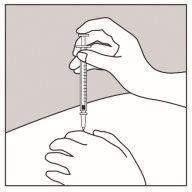
Рисунок 1 Рисунок 2
Если вы считаете, что эффект глатиримера слишком сильный или слабый, сообщите об этом вашему врачу.
Если вы использовали больше Глатиримера Виатрис, чем следует
В случае передозировки или случайного приема проконсультируйтесь немедленно с вашим врачом или фармацевтом или позвоните в Службу токсикологической информации, телефон: 91 562 04 20, указав лекарство и количество, принятое.
Если вы пропустили использование Глатиримера Виатрис
Введение как можно скорее, но не делайте двойную дозу, чтобы компенсировать пропущенные дозы. Следующую дозу введение через 24 часа.
Если вы прекратили лечение Глатиримером Виатрис
Не прекращайте использование глатиримера без консультации с вашим врачом.
Если у вас есть какие-либо другие вопросы о использовании этого лекарства, проконсультируйтесь с вашим врачом или фармацевтом.
4. Возможные побочные эффекты
Как и все лекарства, это лекарство может вызывать побочные эффекты, хотя не все люди испытывают их.
Аллергические реакции (гиперчувствительность, анафилактическая реакция)
Вы можете развить тяжелую аллергическую реакцию на это лекарство вскоре после введения. Это редкий побочный эффект. Эти реакции могут возникнуть через месяцы или годы после начала лечения Глатиримером Виатрис, даже если ранее не было аллергических реакций после предыдущих введений.
Если вы заметите любой из следующих побочных эффектов, прекратите использовать глатиример и немедленно позвоните вашему врачу или обратитесь в ближайший больничный отделение:
- общие высыпания (красные пятна или сыпь),
- отек век, лица или губ, рта, горла или языка.
- внезапная трудность с дыханием, одышка, трудность с дыханием или свистящее дыхание («свист» при дыхании)
- судороги (приступ),
- проблемы с глотанием или речью
- обморок (потеря сознания), чувство головокружения или обморока.
- коллапс
Другие реакции после инъекции (реакция сразу после инъекции)
Редко, но некоторые люди могут испытывать один или несколько следующих симптомов через несколько минут после инъекции глатиримера. Обычно они не представляют проблемы и проходят в течение получаса.
Однако, если следующие симптомы продолжаются более 30 минут, немедленно свяжитесь с вашим врачом или обратитесь в ближайший больничный отделение:
- краснота груди или лица (вазодилатация),
- трудность с дыханием (диспноэ),
- боль в груди,
- быстрые и сильные сердечные сокращения (пальпитации, тахикардия).
Проблемы с печенью
Проблемы с печенью или ухудшение проблем с печенью, включая печеночную недостаточность (которая в некоторых случаях привела к трансплантации печени), могут возникать редко с глатиримером.
Свяжитесь с вашим врачом немедленно, если у вас есть симптомы, такие как:
- тошнота,
- потеря аппетита,
- темная моча и бледный стул,
- желтушная окраска кожи или белой части глаза,
- легкое кровотечение.
Описаны следующие побочные эффекты глатиримера:
Очень часто(могут возникать у более 1 из 10 человек)
- инфекции, грипп
- тревога, депрессия
- головная боль
- тошнота
- сыпь на коже
- боль в суставах или спине
- чувство слабости, реакции кожи в месте инъекции, включая покраснение кожи, боль, образование пузырей, зуд, отек тканей, воспаление и гиперчувствительность (эти реакции в месте инъекции не являются аномальными и обычно проходят со временем), неспецифическая боль.
Часто(могут возникать у до 1 из 10 человек)
- воспаление дыхательных путей, желудочный грипп, лихорадка, воспаление ушей, насморк, абсцессы зубов, вагинальный кандидоз
- доброкачественные новообразования кожи (доброкачественные кожные опухоли), новообразования
- отек лимфатических узлов
- аллергические реакции
- потеря аппетита, набор веса
- нервозность
- нарушение вкуса, увеличение мышечного тонуса, мигрень, проблемы с речью, обморок, тремор
- двойное зрение, проблемы с глазами
- проблемы со слухом
- кашель, сенная лихорадка
- анальные или прямокишечные проблемы, запор, кариес зубов, диспепсия, трудности с глотанием, недержание кала, рвота.
- анормальные результаты функциональных тестов печени
- гематомы, чрезмерное потоотделение, зуд, кожные нарушения, крапивница
- боль в шее
- необходимость быстро опорожнить мочевой пузырь, частое мочеиспускание, неспособность полностью опорожнить мочевой пузырь
- простуда, отек лица, потеря ткани под кожей в месте инъекции, местная реакция, периферический отек из-за накопления жидкости, лихорадка.
Редко(могут возникать у до 1 из 100 человек)
- абсцессы, воспаление кожи и подлежащих тканей, фурункулы, герпес, воспаление почек
- кожный рак
- увеличение количества белых кровяных клеток, уменьшение количества белых кровяных клеток, увеличение селезенки
- уменьшение количества тромбоцитов, изменение формы белых кровяных клеток
- увеличение щитовидной железы или гиперактивность щитовидной железы
- пониженная толерантность к алкоголю, подагра, увеличение уровня жиров в крови, увеличение натрия в крови, уменьшение ферритина в крови.
- страные сны, путаница, эйфорическое состояние, видение, слышание, обоняние, осязание или ощущение вещей, которые не существуют (галлюцинации), агрессивность, аномально счастливое состояние, расстройства личности, попытка самоубийства
- онемение рук и боль (синдром запястного канала), психические расстройства, приступы (судороги), проблемы с письмом и чтением, мышечные расстройства, проблемы с движением, мышечные спазмы, воспаление нервов, аномальная нервно-мышечная связь, вызывающая аномальную мышечную функцию, быстрое и непроизвольное движение глазных яблок, паралич, падающая стопа (паралич перонеального нерва), бессознательное состояние (ступор), слепые пятна.
- катаракта, повреждения глазной роговицы, сухость глаз, кровотечение в глазу, опущение верхнего века, расширение зрачка, истончение оптического нерва, вызывающее проблемы с зрением.
- учащенное сердцебиение, замедленное сердцебиение, эпизоды учащенного сердцебиения
- варикозное расширение вен
- периодические остановки дыхания, носовое кровотечение, аномально быстрое или глубокое дыхание (гипервентилация), чувство сужения горла, проблемы с легкими, неспособность дышать из-за сужения горла (чувство удушья)
- воспаление тонкого кишечника, полипы в толстой кишке, воспаление кишечника, отрыжка, язва пищевода, воспаление десен, кровотечение из прямой кишки, увеличение слюнных желез
- желчные камни, увеличение печени
- отек кожи и подлежащих тканей, контактный дерматит, болезненные красные узлы на коже, узлы на коже
- отек, воспаление и боль в суставах (артрит или остеоартрит), воспаление и боль в суставных сумках (существующих в некоторых суставах), боль в боку, уменьшение мышечной массы
- кровь в моче, камни в почках, проблемы с мочевой системой, аномалии мочи
- отек груди, трудности с эрекцией, опущение тазовых органов (опущение тазового дна), длительная эрекция, проблемы с предстательной железой, аномальный результат мазка Папаниколау (анормальный мазок шейки матки), проблемы с яичками, вагинальное кровотечение, вагинальные расстройства.
- киста, похмелье, пониженная температура тела (гипотермия), неспецифическое воспаление, разрушение тканей в месте инъекции, проблемы с слизистыми оболочками
- нарушения после вакцинации
Сообщение о побочных эффектах
Если вы испытываете любой тип побочного эффекта, проконсультируйтесь с вашим врачом или фармацевтом, даже если это побочные эффекты, которые не указаны в этом прошпекте. Вы также можете сообщить об этом напрямую через Испанскую систему фармакологического надзора за лекарствами для человека: https://www.notificaram.es.
Сообщая о побочных эффектах, вы можете внести свой вклад в предоставление более полной информации о безопасности этого лекарства.
5. Хранение Глатирамера Виатрис
Хранить это лекарство в недоступном для детей месте.
Хранить в холодильнике (при температуре между 2°C и 8°C).
Предварительно заполненные шприцы Глатирамера Виатрис можно хранить до одного месяца вне холодильника, при температуре между 15°C и 25°C. Это можно сделать только один раз. Если после месяца предварительно заполненные шприцы Глатирамера Виатрис не были использованы и находятся в оригинальной упаковке, их необходимо снова хранить в холодильнике.
Не замораживать.
Хранить предварительно заполненные шприцы в наружной упаковке, чтобы защитить их от света.
Не использовать это лекарство после даты истечения срока годности, указанной на этикетке и картонной упаковке после CAD или EXP. Первые два знака указывают месяц, а последние четыре знака - год. Дата истечения срока годности - последний день указанного месяца.
Утилизировать любой шприц, содержащий частицы.
Лекарства не должны выбрасываться в канализацию или мусор. Спросите у вашего фармацевта, как утилизировать упаковку и лекарства, которые вам больше не нужны. Таким образом, вы поможете защитить окружающую среду.
6. Содержание упаковки и дополнительная информация
Состав Глатирамера Виатрис
- Активное вещество - ацетат глатирамера. 1 мл раствора для инъекции (содержимое 1 предварительно заполненного шприца) содержит 20 мг ацетата глатирамера.
- Другие компоненты - маннитол (Е 421) и вода для инъекций.
Внешний вид продукта и содержание упаковки
Глатирамер Виатрис - стерильный, прозрачный, бесцветный или слегка желтоватый/коричневатый раствор.
Если раствор содержит частицы, утилизируйте его и начните заново. Используйте новый шприц.
7 предварительно заполненных шприцев
28 предварительно заполненных шприцев
30 предварительно заполненных шприцев
90 (3х30) предварительно заполненных шприцев
Возможно, не все размеры упаковок будут доступны для продажи.
Владелец разрешения на маркетинг
Viatris Limited
Промышленный парк Дамастаун
Мулхуддарт, Дублин 15
Дублин
Ирландия
Производитель
Synthon Hispania S.L.
Кастельо 1
Промышленная зона Лес Салинес
08830 Сант-Бой-де-Льобрегат (Барселона)
Испания
Или
Synthon BV
Микровег 22
6545 CM Неймеген
Нидерланды
Вы можете получить дополнительную информацию о этом лекарстве, обратившись к местному представителю владельца разрешения на маркетинг:
Viatris Pharmaceuticals, S.L.U.
Улица Генерала Аранаса, 86
28027 - Мадрид
Испания
Это лекарство разрешено в государствах-членах Европейского экономического пространства под следующими названиями:
Германия: CLIFT 20 мг/мл раствор для инъекции в предварительно заполненном шприце
Бельгия: Glatiramyl 20 мг/мл, раствор для инъекции в предварительно заполненном шприце
Испания: Глатирамер Виатрис 20 мг/мл раствор для инъекции в предварительно заполненном шприце
Франция: GLATIRAMER MYLAN 20 мг/мл, раствор для инъекции в предварительно заполненном шприце
Италия: COPEMYL
Нидерланды: Glatirameeracetaat Mylan 20 мг/мл, раствор для инъекции в предварительно заполненном шприце
Португалия: Ацетат глатирамера Милан
Многоразовый инъектор разрешен в государствах-членах Европейского экономического пространства и в Великобритании (Северная Ирландия) под следующими названиями:
MyJect
Дата последнего обновления этой инструкции:ноябрь 2024 г.
Подробная информация о этом лекарстве доступна на сайте Агентства по лекарствам и медицинским изделиям Испании (AEMPS) http://www.aemps.gob.es/
- Страна регистрации
- Активное вещество
- Требуется рецептДа
- Производитель
- Информация носит справочный характер и не является медицинской рекомендацией. Перед приемом любых препаратов проконсультируйтесь с врачом. Oladoctor не несет ответственности за медицинские решения, принятые на основе этого контента.
- Аналоги ГЛАТИРАМЕРО ВИАТРИС 20 мг/мл РАСТВОР ДЛЯ ИНЪЕКЦИЙ В ПРЕДНАПОЛНЕННОМ ШПРИЦЕФорма выпуска: ИНЪЕКЦИОННЫЙ РАСТВОР, 20 мг ацетата глатирамера / млАктивное вещество: Глатирамер ацетатПроизводитель: Teva GmbhТребуется рецептФорма выпуска: ИНЪЕКЦИОННЫЙ РАСТВОР, 40 мг/млАктивное вещество: Глатирамер ацетатПроизводитель: Teva GmbhТребуется рецептФорма выпуска: ИНЪЕКЦИОННЫЙ РАСТВОР, 40 мг/млАктивное вещество: Глатирамер ацетатПроизводитель: Viatris LimitedТребуется рецепт
Аналоги ГЛАТИРАМЕРО ВИАТРИС 20 мг/мл РАСТВОР ДЛЯ ИНЪЕКЦИЙ В ПРЕДНАПОЛНЕННОМ ШПРИЦЕ в других странах
Лучшие аналоги с тем же действующим веществом и терапевтическим эффектом.
Аналог ГЛАТИРАМЕРО ВИАТРИС 20 мг/мл РАСТВОР ДЛЯ ИНЪЕКЦИЙ В ПРЕДНАПОЛНЕННОМ ШПРИЦЕ в Polónia
Аналог ГЛАТИРАМЕРО ВИАТРИС 20 мг/мл РАСТВОР ДЛЯ ИНЪЕКЦИЙ В ПРЕДНАПОЛНЕННОМ ШПРИЦЕ в Ukraine
Врачи онлайн по ГЛАТИРАМЕРО ВИАТРИС 20 мг/мл РАСТВОР ДЛЯ ИНЪЕКЦИЙ В ПРЕДНАПОЛНЕННОМ ШПРИЦЕ
Консультация по дозировке, побочным эффектам, взаимодействиям, противопоказаниям и продлению рецепта на ГЛАТИРАМЕРО ВИАТРИС 20 мг/мл РАСТВОР ДЛЯ ИНЪЕКЦИЙ В ПРЕДНАПОЛНЕННОМ ШПРИЦЕ – по решению врача и с учетом местных правил.














